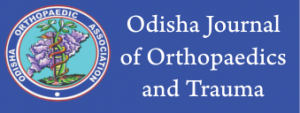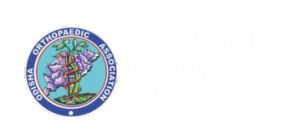Haglund deformity – Resection by lateral approach: A case report and review of literature
Vol 01 | January 2020 | page: 31-33 | Siddhartha Shankar Mohanty, Satya Ranjan Patra, Hemanta Kumar Bamidi, Kishore Chandra Das
DOI- 10.13107/ojot.2020.v41i01.010
Authors: Siddhartha Shankar Mohanty [1], Satya Ranjan Patra [1], Hemanta Kumar Bamidi [1], Kishore Chandra Das [1]
[1] Department of Orthopaedics, Hi-Tech Medical College, Bhubaneswar, Odisha India.
Address of Correspondence
Dr. SatyaRanjan Patra,
Hi-Tech Medical College, Bhubaneswar, Odisha India.
E-mail: drsatyarp@gmail.com
Abstract
Haglund’s syndrome is a mechanical cause of posterior heel pain leading to functional and sporting disability. It is due to a conflict between the achilles tendon and the postero-superior hypertrophied tuberosity of the calcaneus. Physical examination and standard imaging studies are usually sufficient to establish the diagnosis. The treatment is primarily medical; surgery is indicated after failure of functional treatment and it consists of a resection of the posterior-superior bone prominence of the calcaneus with a good results. In some cases tendo-Achilles repair may be needed. We describe a case of symptomatic Haglund’s syndrome that was treated by excision of the mass through lateral approach without tendo-Achilles reconstruction.
Keywords: Haglund’s syndrome, Calcaneus, Surgical excision, Achilles tendon.
References
1. Clancy WG. Runners’ injuries. Part two. evaluation and treatment of specific injuries. Am J Sports Med 1980;8:287-9.
2. Fiamengo SA, Warren RF, Marshall JL, Vigorita VT, Hersh A. Posterior heel pain associated with a calcaneal step and Achilles tendon calcification. ClinOrthopRelat Res 1982;162:203-11.
3. Haglund P. Beitragzurklinik der Achilles tendon. ZeitschrOrthopChir 1928;49:49-58.
4. Jerosch J, Schunck J, Sokkar SH. Endoscopic calcaneoplasty (ECP) as a surgical treatment of haglund’s syndrome. Knee Surg Sports TraumatolArthrosc 2007;15:927-34.
5. Van Dijk CN, van Dyk CE, Scholten PE, Kort NP.Endoscopic calcaneoplasty. Foot Ankle Clin 2006;2:439-46.
6. Pavlov H, Heneghan MA, Hersh A, Goldman AB, Vigorita V. The Haglund syndrome: initial and differential diagnosis. Radiology. 1982;144(1):83-8.
7. Haglund P. BeitragzurKlinik der Achillessehne. Z OrthopChir.1927; 49: 49-58.
8. McGarvey WC, Palumbo RC, Baxter DE, Leibman BD. Insertional Achilles tendinosis: surgical treatment through a central tendon splitting approach. Foot Ankle Int. 2002; 23: 19-25.
9. McGarvey WC, Palumbo RC, Baxter DE, Leibman BD. Insertional Achilles tendinosis: surgical treatment through a central tendon splitting approach. Foot Ankle Int. 2002; 23: 19-25.
10. Dr O. Laffenetre, Dr J. Lucas, Pr D. Chauveaux Document d’information du patient sur le syndrome de HAGLUND CHU – Hopitaux de Bordeaux. 2011.
11. Angermann P. Chronic retrocalcaneal bursitis treated by resection of the calcaneus. Foot Ankle. 1990;10(5):285-7.
12. Green AH, Hass MI, Tubrity SP, Goldberg MM, Perry JB. Calcaneal osteotomy for retrocalcaneal exostosis.ClinPodiatr Med Surg. 1991;8:659-65.
13. Lu CC, Cheng YM, Fu YC, Tien YC, Chen SK. Angle analysis of Haglund syndrome and its relationship with osseous variations and Achilles tendon calcification. Foot Ankle Int. 2007;28(2):181-5.
14. Sammarco GJ, Taylor AL. Operative management of Haglund deformity in the non athlete: a retrospective study. Foot Ankle Int. 1998;19:724-9.
15. Sella EJ, Caminear DS, McLarney EA. Haglund syndrome. J Foot Ankle Surg. 1998;37:110-4.
16. Anderson JA, Suero E, O’Loughlin PF, Kennedy JG. Surgery for Retrocalcaneal Bursitis: A Tendon-splitting versus a Lateral Approach. ClinOrthopRelat Res. 2008;466(7):1678-82.
17. V.Gulati, M. Jaggard, S. S. Al-Nammari et al., “Management ofachilles tendon injury: a current concepts systematic review,”World Journal of Orthopaedics, vol. 6, no. 4, pp. 380–386, 2015.
| How to Cite this Article: Mohanty S S, Patra S R, Bamidi H K, Das K C. | Haglund deformity – resection by lateral approach: a case report and review of literature. | Odisha Journal of Orthopaedics and Trauma | January 2020; 01: 31-33. https://doi.org/10.13107/ojot.2020.v41i01.010 |
(Abstract Text HTML) (Download PDF)


